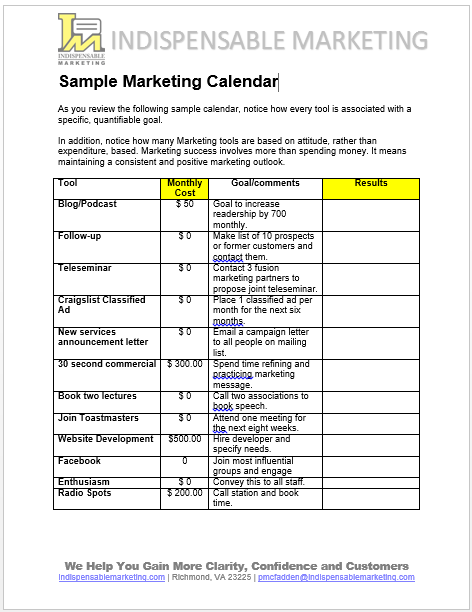The Small Business Marketing Calendar
If you’re a small business owner, there’s always more to do than time in a day, week or month?
The key to de-stressing your life, growing your reach, scaling your marketing, and coordinating marketing activities is advance planning for what needs to be done.
When you prioritize what’s important, decision making gets a heck of alot easier and you and your staff will focus on the tasks that produce wins.
One of the foundational elements of the Indispensable Marketing Process is the idea of managing and planning your marketing by the marketing calendar. You know the rule: If it doesn’t get scheduled, it will never get done.
There’s something very powerful about the visual reminder that you’ve committed to making that follow-up phone call every month for example.
While many people are familiar with the idea of a marketing calendar, few actually live by it.
Over the years I’ve also trained business owners to use the marketing calendar in another very powerful way. These three things can take your business to the net level:
- Choosing action items. The act of choosing, is the act of succeeding. When creating a marketing plan part of the deal is that you can’t get everything (tactical activities) that you possibly want done. The best way to approach the situation is by choosing marketing strategies and tactics that align with your business goals. Do you need press releases for awareness goals? Will the website need updating to capture qualified leads? Is researching main competitors a priority for communicating a unique position?
- Managing marketing activities. Measuring and control are parts of good management. Using a simple chart or marketing dashboard to monitor marketing initiatives and accountability will increase implementation effectiveness. If you don’t have a chart or dashboard, use the plan itself as a weekly review tool.
- Daily follow-ups. When it comes right down to it, marketing plans fail because those responsible for getting specific tasks done aren’t being followed up with. Following up and checking due dates on a regular basis will increase the effectiveness of your marketing. Poor execution will always trace back to poor follow-up. This is tough for start-ups and small business owners because of distractions, deliveries, and everyday business routines that have to be done.





